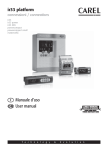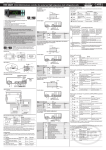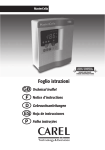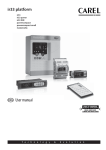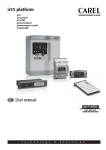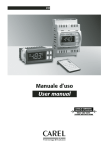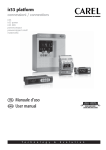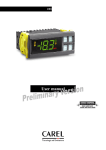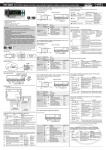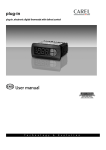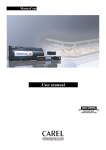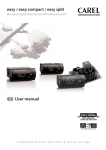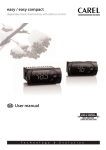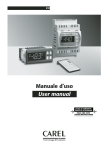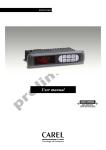Download Manual - Carel
Transcript
+0500018EN - rel. 3.2 del 01.04.2008 PB00* - powercompact Models PB00(S,Y,F,C,H)(0,6)(0,E,A,H)(N,R,C,B,A,M,L,T,P,Q,S,U,V,X,Y,Z)(1,2,3,4,5,A,B,C,D,E,F)0 Option codes NO POWER & SIGNAL CABLES TOGETHER READ CAREFULLY IN THE TEXT! WARNING: separate as much as possible the probe and digital input signal cables from the cables carrying inductive loads and power cables to avoid possible electromagnetic disturbance. Never run power cables (including the electrical panel wiring) and signal cables in the same conduits. CODE IRTRRES000 IROPZ48500 IROPZ485S0 IROPZDSP00 PST00VR100 IR00RG0000 IR00RR0000 PSTCON01B0 PSTCON03B0 PSTCON05B0 PSOPZKEY00 PSOPZKEYA0 IROPZKEY00 IROPZKEYA0 VPMSTDKY*0 Dimensions (mm) powercompact: Display 36 28.2 powercompact uses a built-in display terminal with three LED digits and icon, to display the operating status. An additional display can be connected to the powercompact controller, via a suitable interface for example to display the reading of a third probe. 64 167 75 Icon dima di foratura drilling template 138.5 x 29mm Function versione con faston + 8 mm faston version + 8 mm COMPRESS. ON compressor ON FAN fan ON 153.5 AUX fan OFF defrost ON defrost OFF defrost request auxiliary output AUX active auxiliary output AUX not active ALARM delayed external alarm (before the expiry of the time ‘A7’) no alarm present anti-sweat heater function active alarms in normal operation (e.g. high/ low temperature) or alarm from external digital input, immediate or delayed CLOCK if at least 1 timed defrost has been set no timed defrost is clock alarm present LIGHT auxiliary output LIGHT active auxiliary output LIGHT not active anti-sweat heater function active malfunction (e.g. EEPROM error or probe fault) HACCP alarm (HA and/or HF) 8 versione con faston + 8 mm faston version + 8 mm 153.5 SERVICE 165 36 28,5 dima di foratura drilling template 71x29mm Fig. 1 41.7 HACCP function enabled CONTINUOUS CYCLE CONTINUOUS CYCLE enabled HACCP function not enabled ON if realtime clock present 2 Button Pressing the button alone other ON/OFF PRG/ MUTE powercompact PB wide: UP/CC LUCE AUX PST00VR100: repeater display interface 2 1 DOWN/ DEF 3 tipo Pozidriv tipo Pozidriv Panel mounting: by two countersunk screws, max. diameter 3.9 mm. NO EXCEDER EN EL AJUSTE NÃO EXAGERAR NO APERTO max 2.5 SET Fig. 2 2. Pressing the on an instrument connected to the network recognises the message sent by the remote application, automatically sets the address to the desired value and sends a confirmation message to the application, containing the unit code and firmware revision (message ‘V’). When the message sent by the remote application is recognised, the instrument shows the message ‘Add’ on the display for 5 seconds, followed by the value of the serial address assigned; 3. The application, on receiving the confirmation message from the units connected to the network, saves the information received in its database, increases the serial address and sends the message ‘<!ADR>’ again; 4. At this point, the procedure starting from point 2 can be repeated on another unit connected to the network, until defining all the network addresses. Pressing together with buttons address 1. Hold the button for more than 5 s (if there are active alarms, first mute the buzzer), the display will show the first modifiable “F” parameter. Modifying the parameters After having displayed the parameter, either type “C” or type “F”, proceed as follows: 1. Press the or button to scroll the parameters, until reaching the parameter to be modified; when scrolling, an icon appears on the display representing the category the parameter belongs to. 2. Alternatively, press the button to display a menu that is used to quickly access the category of parameters to be modified. Request Start-up automatic assignment enters the menu to HACCP display and delete the HACCP alarms 1 This is a special procedure that, using an application installed on a PC, allows setting and managing simply the addresses of all instruments (featuring this function) connected to the CAREL network. The procedure is very simple: 1. Using the remote application. The “Network definition” procedure started; the application sends a special message (‘<!ADR>’) across the CAREL network, containing the network address. Accessing the configuration parameters (type F) CONTINUOUS CONTINUOUS CYCLE CYCLE not enabled request Normal operation Icon Automatic assignment of the serial address 2. Press the or button until displaying the number “22” (parameter access password) 3. Confirm by pressing the “set” button. 4. The display shows the code of the first modifiable “C” parameter. The blinking status indicates a request for activation that cannot be implemented until the end of the corresponding delay times. powercompact: Panel mounting: by two lateral sliding plastic brackets. buttons; 1. Press the and “set“ buttons at the same time for more than 5 seconds; the display will show the number “00” (password prompt). Buttons on the keypad Panel mounting and button until the message “Std” is shown on the display Accessing the configuration parameters (type C) Tab. 2 35 81 no malfunction HACCP PST00VR100: repeater display interface and “Hdn”, using the 4. press the Start up fan request 75 dima di foratura drilling template da 138.5 a 150 x 31mm blink compressor request AUX 64 183.4 Normal operation OFF compressor OFF DEFROST 28.2 powercompact PB wide: If “Hdn” < > 0: 1: switch the instrument off; 2: switch the instrument back on, holding the button until the value 0 is shown on the display; 3: select the set of default parameters, between 0 Note: once the address has been assigned to an instrument, the operation, for safety reasons, is disabled on the same instrument for 1 minute, preventing a different address from being assigned to the instrument. Signals on the display 8 39.4 • DESCRIPTION small remote control RS485 serial inteface RS485 serial board interface with automatic recognition of the polarity +/remote display interface remote repeater display remote repeater display ir33 range green display remote repeater display ir33 range red display repeater display connection cables 1,5 m repeater display connection cables 3 m repeater display connection cables 5 m parameter programming key with extended memory and 12 V batteries included parameter programming key with 230 Vac power supply parameter programming key with 12 V battery included parameter programming key with extended memory and external 230 Vac power supply key programming kit Tab. 1 if pressed for more than 5 s, switches the unit on/off 3. Scroll the menu with the and buttons; the display shows the codes of the various categories of parameters (see the Summary of operating parameters), accompanied by the display of the corresponding icon (if present). 4. Once having reached the desired category, press “set” to go directly to the first parameter in the chosen category (if no parameter is visible, pressing the “set” button will have no effect). 5. At this stage, modify the parameters or return to the “Categories” menu, using the 6. Press “set” to display the value associated with the parameter. button. 7. Increase or decrease the value using the or buttons respectively. 8. Press “set” to temporarily save the new value and return to the display of the parameter. 9. Repeat the operations from point 1 or point 2. 10. If the parameter has sub-parameters, press “set” to display the first sub-parameter. 11. Press the or button to display all the sub-parameters. 12. Press “ set” to display the associated value. if pressed for more than 5 s, accesses the • SET: if pressed for more than 5 s together menu for setting type with the SET button accesses the menu for setting the type “C” (configuration) or “F” (frequent) parameters in the event downloading the parameters of alarm: silences the • UP/CC: if pressed for more than 5 s togeaudible alarm (buzzer) ther with the UP/CC button, resets any and disables the alarm active alarms with manual reset relay • SET: if pressed for more than 5 s together with the SET button, starts the procedure if pressed for more for printing the reports (function available, than 5 s, enables/ with management to be implemented) disables continuous • PRG/MUTE: if pressed for more than 5 s tocycle operation gether with the PRG/MUTE button, resets any active alarms with manual reset if pressed for more than 1 s, enables/disables auxiliary AUX2 if pressed for more than 1 s, enables/disables auxiliary AUX1 if pressed for more than 5 s, enables/ disables a manual defrost • PRG/MUTE: if pressed for more than 5 s together with the PRG/MUTE button accesses the menu for setting the type “C” (configuration) or downloading the if pressed for more parameters than 1 s, displays and/ • UP/CC: if pressed for more than 5 s or sets the set point together with the UP/CC button, starts the procedure for printing the reports (function available, with management to be implemented) if pressed for more if pressed for than 5 s at more than 1 start-up, s, enters the enables the automatic procedure serial address for setting assignment the default procedure values 13. Increase or decrease the value using the or button respectively. 14. Press “set” to temporarily save the new value and return to the display of the sub-parameter code. 15. Press to return to the display of the parent parameter. Saving the new values assigned to the parameters To definitively save the new values of the modified parameters, press the button for more than 5 seconds, thus exiting the parameter setting procedure. All the modifications made to the parameters, temporarily saved in the RAM, can be cancelled and “normal operation” resumed by not pressing any button for 60 seconds, thus allowing the parameter setting session to expire due to timeout. If the instrument is switched off before pressing the button, all the modifications made to the parameters and temporarily saved will be lost. Directly accessing the parameters by selecting the category The configuration parameters can also be accessed, in addition to the mode described above, via the category (see the icons and abbreviations in the table below), according to the list on the display with the corresponding name and icon. To directly access the list of parameters grouped by category, press the button for at least 1 second, Category Probe parameters Control parameters Compressor parameters Defrost parameters Alarm parameters Fan parameters Configuration parameters HACCP parameters RTC parameters , and to modify the parameter press “set” , Parameters / r c d A F H H HACCP rtc Message ‘Pro’ ‘CtL ‘CMP’ ‘dEF’ ‘ALM’ ‘FAn’ configuration ‘CnF’ ‘HcP’ ‘rtc’ Icon Tab. 4 Tab. 3 Wiring diagrams Probe configuration (/A2.../A5) Setting the set point (desired temperature value) PB00C To display or set the set point, proceed as follows: 1. press the “set” button for more than 1 second to display the set point; and 2. increase or decrease the value of the set point, using the reaching the desired value; 3. press the “set” button again to confirm the new value. Fig. 3 buttons respectively, until In the powercompact series, this parameter and the model of controller used define the meaning of the digital input: and buttons together for more 3= As well as the automatic defrost function, a manual defrost can be enabled, if the temperature for 5 seconds. conditions allow, by pressing 4= 5= 6= 7= 8= 9= 10 = 11 = 12 = 13 = 14 = ON/OFF button Pressing this button for 5 s switches the unit on/off. When the controller is turned off, it actually goes into standby, and therefore, when carrying out maintenance on the device, it must be disconnected from the power supply. HACCP function Fig. 5 PB00H Fig. 6 powercompact is compliant with the HACCP standards in force since it allows the monitoring of the temperature of the stored food. “HA” alarm = exceeded maximum threshold: up to three HA events are saved (HA, HA1, HA2) respectively from the more recent (HA) to the oldest (HA2) and a HAn signal that displays the number of occurred HA events. “HF” alarm = power failure lasting over a minute and exceeded AH maximum threshold: up to three HF events are saved (HF, HF1, HF2) respectively from the more recent (HF) to the oldest (HF2) and a HFn signal that displays the number of occurred HF events. HA/HF alarm setting: AH parameter (high temperature threshold); Ad and Htd (Ad+Htd = HACCP alarm activation delay). Display of the details: access to HA or HF parameters pressing the or . buttons to glance over. HACCP alarm erasing: press the “HACCP” “HACCP” button and use button for more than 5 s, the message ‘res’ indicates that the alarm have been deleted.To cancel the saved alarms press the “HACCP” and buttons for more than 5 s. PB00S Continuous cycle Fig. 7 0= 1= 2= Manual defrost Fig. 4 PB00F0H 0 = probe absent; 1 = product probe (used for display only); 2 = defrost probe; 3 = condenser probe; 4 = antifreeze probe. Configuration of the digital inputs (A4, A5, A9) Alarms with manual reset The alarms with manual reset can be reset by pressing the than 5 s. PB00F0E In the powercompact series, these parameters are used to configure the operating mode of the probes: Pressing the button for more than 5 seconds enables the continuous cycle function. During operation in continuous cycle, the compressor continues to operate for the time ‘cc’ and it stops when reaches the ‘cc’ time out or the minimum temperature envisaged (AL = minimum temperature alarm threshold). Continuous cycle setting: “cc” parameter (continuous cycle duration): “cc” = 0 never active; “c6” parameter (bypassing the alarm after the continuous cycle): it avoids or delays the low temperature alarm after the continuous cycle. input not active; immediate external alarm, normally closed: open = alarm; delayed external alarm, normally closed; enable defrost from external contact: open= disabled (an external contact can be connected to the multifunction input to enable or disable the defrost); start defrost from external contact; door switch with stopping of compressor and fans: open = open door; remote ON/OFF: CLOSED=ON; curtain switch: close = lowered curtain; low pressure switch input for pump-down: open = low pressure; door switch with stopping of fans only: open = open door; direct/reverse cycle operation: open = direct; light sensor; AUX output enabling (if configured with H1 o H5 parameters): opening = enabling; door switch with compress. and fans OFF, with light not managed; door switch with fans OFF and light not managed. Configuration of the relay outputs AUX1 (H1) and AUX2 (H5) Establishes whether relays AUX1 and AUX2 (present only if envisaged by the model) are used as auxiliary outputs (e.g. demister fan or other ON/OFF actuator), an alarm output, a light output, a defrost actuator for the auxiliary evaporator, pump-down valve control or output for the condenser fan. 0 = alarm output: normally energised; the relay is de-energised when an alarm occurs; 1 = alarm output: normally de-energised; the relay is energised when an alarm occurs; 2 = auxiliary output; 3 = light output; 4 = auxiliary evaporator defrost output; 5 = pump-down valve output; 6 = condenser fan output; 7 = delayed compressor output; 8 = auxiliary output with OFF shutdown; 9 = light output with OFF shutdown; 10 = disabled output; 11 = reverse output in dead zone control; 12 = second compressor step output; 13 = second compressor step output with rotation. Warning: the mode H1/H5=0 is useful for signalling the alarm status even in case of power failure. PB00Y Procedure for setting the default parameter values To set the default parameter values on the controller, proceed as follows: • 5 (4)A 5A 1FLA 6LRA Fig. 8 If “Hdn” = 0: 1: switch the instrument off; 2: switch the instrument back on, holding the button until the message “Std” is shown on the display. Note: the default values are only set for the visible parameters (C and F). For further details see table“Summary of operating parameters”. Note: in the models fitted with only one auxiliary output, to associate the button “ ” to this output, set H1= 10 and H5= 3. It is necessary to associate the relay assigned to aux 1 to the auxiliary output 2. The operation can be performed using the programming kit PSOPZPRG00 and the programming key PSOPZKEY00/A0. IROPZDSP00: Opzione interfaccia display Display interface option IROPZ485S0: Interfaccia scheda seriale RS485 intelligente Smart serial board interface RS485 Fig. 9 /tE /P Technical specification Model E Power supply A H Voltage 230 V~ (+10%, -15%), 50/60 Hz 230 V~ (+10%, -10%), 50/60 Hz (vers. 16 A, 8A, 8A) 115 V~ (+10%, -15%), 50/60 Hz 115 V~ (+10%, -10%), 50/60 Hz (vers. 16 A, 8A, 8A) 115 to 230 V~ (switching) (+10%,-15%), 50/60 Hz Power 3 VA, 25 mA~ max. 3 VA, 50 mA~ max. 6 VA, 50 mA~ max. 3 VA, 300 mA~ max. To use only the transformer TRA12VDE00 with 315 mA slow-blow fuse in the secondary insulation in reference reinforced 6 mm in air, 8 mm E, A, H to very low voltage parts on surface 3750 V insulation primary 3 mm in air, 4 mm insulation from relay outputs on surface 1250 V insulation Insulation guaranteed by the power supply insulation in reference externally guaranteed 0 to very low voltage parts by safety transformer primary 3 mm in air, 4 mm insulation from relay outputs on surface 1250 V insulation S1 NTC or PTC, depending on the model S2 NTC or PTC, depending on the model free contact, contact resistance < 10 Ω, closing current 6 mA DI1/S3 NTC or PTC, depending on the model Inputs free contact, contact resistance < 10 Ω, closing current 6 mA DI2 / S4 NTC or PTC, depending on the model Maximum distance of probes and digital inputs less than 10 m Note: During installation keep the power and load connections separate probe cables, digital inputs, repeater display and supervisory system. measurement error NTC high 1.5 °C in the –40T150 °C range 50 kΩ at 25 °C, temperature 4 °C in the external range at range from –40T150 °C -20T115 °C measurement error Probe type Std. CAREL NTC 10 kΩ at 25 °C, 1 °C in the –50T50 °C range range from –50T90 °C 3 °C in the –50T90 °C range measurement error: Std. CAREL PTC 985 Ω at 25 °C, 2 °C in the –50T50 °C range (specific model) range from -50T150 °C 4 °C in the –50T150 °C range depending on the model EN60730-1 UL 873 operating operating 250 V~ 250 V~ cycles cycles 5 A resistive 1 FLA 5 (1) A 100000 30000 5A* 6 LRA C 300 8 (4) A on N.O. 6 (4) A on N.C. 2 (2) A if the N.C. and 8 A resistive 2 30000 100000 8A* N.O. contacts are FLA 12 LRA C300 Uscite relè Relay outputs connected contemporaneously 10 (4) A up to 60 °C 12 A resistive on N.O. 12 (2) A 100000 5FLA 30 LRA 30000 16 A* on N.O. and N.C. C300 12 A resistive 12 2 Hp 10 (10) A 100000 30000 FLA 72 LRA insulation from very low voltage reinforced 6 mm in air, 8 mm on surface parts 3750 V insulation insulation between the relay primary 3 mm in air, 4 mm on surface outputs 1250 V insulation * relay not suitable for fluorescent loads (neon lights, ...) that use starters (ballasts) with phase-shift capacitors. Fluorescent lamps with electronic control devices or without phase-shift capacitors can be used, within the operating limits specified for each type of relay. Maximum Type of connection Cross-section current fixed screw-on removable for screw for wires from 0.5 to 2.5 mm2 12 A blocks faston with crimped contacts Connections The installer has to provide the correct dimensioning of the power supply and cable connection between the instrument and the loads. In max load and max operating temp. conditions, cables rated for operation at up to 105 °C are required. dimensions 36x167x75 mm Case plastic mount-in depth 64 mm using screws from front panel dimensions panel drilling template 29x138.5 mm distance between fastening screws 153.5 mm Mounting countersunk with tread diameter 3.9 mm fastening screws maximum dimensions 39.4x183x75 mm Case (wide version) plastic mounting depth 63 mm on smooth, hard and indeformable using screws from the front or brackets panel dimensions from 138.5x29 to 150x31 Installation drilling template spacing between fastening screws 165 mm (wide version) or 153.5 mm countersunk with maximum thread diameter fastening screws 3.9 mm for 165 mm spacing; for 153 spacing, flat head with max. thread diameter 3 mm digits 3 digit LED Display display range from –99 to 999 operating status indicated by graphic icons on the display Keypad 8 rubber silicon buttons Infrared receiver available depending on the model Clock with backup available depending on the model battery Buzzer available on all models error at 25 °C ±10 ppm (±5,3 min/year) error in the temperature range -50 ppm (-27 min/year) -10T60 °C Clock ageing < ±5 ppm (±2,7 min/year) discharge time 6 months (max. 8 months) recharge time typical 5 hours (<8 hours max.) Operating temperature -10T65 °C Operating humidity <90% r.H. non-condensing Storage temperature -20T70 °C Storage humidity <90% r.H. non-condensing Front panel index of protection smooth and stiff panel installation with gasket IP65 Environmental pollution 2 (normal) PTI of the insulating material printed circuit board 250, insulation 175 Period of electric stress across insulating parts long Category of resistance to fire category D and category B (UL 94-V0) Class of protection against voltage surges category II Type of disconnection or interruption 1.B relay contacts (micro-disconnection) Construction of control incorporated control, electronically Classification according to protection against Class II, by appropriate incorporation electric shock The control is either to be hand-held or is no intented for a hand-held equipment Software class and structure class A Front panel cleaning only use neutral detergents and water Serial interface for CAREL network external, available on all models Interface for repeater display external, available on models with H and 0 power supply Max. distance between interface and display 10 mt Programming key available for all models 0 /A2 12 V~ (+10%, -15%), 50/60 Hz 12 Vdc, 12 to 18 Vdc The powercompact range fitted with the standard CAREL NTC probe is compliant with standard EN 13485 on thermometers for measuring the air temperature in applications on units for the conservation and sale of refrigerated, frozen and deep-frozen food and ice cream. Designation of the instrument: EN13485, air, S, A, 1, - 50T90 °C. The standard CAREL NTC probe is identifiable by the printed laser code on “WP” models, or the code “103AT-11” on “HP” models, both visible on the sensor part. CAREL INDUSTRIES - HQs Via dell’Industria, 11 – 35020 Brugine – Padova (Italy) Tel. (+39) 0499716611 – Fax (+39) 0499716600 e-mail: [email protected] – www.carel.com /A3 /A4 /A5 /c1 /c2 /c3 /c4 St rd rn rr r1 r2 r3 r4 r5 rt rH rL c0 c1 c2 c3 c4 cc c6 c7 c8 c9 c10 c11 d0 dI dt1 dt2 dP1 dP2 d3 d4 d5 d6 dd d8 d8d d9 d/1 d/2 dC d10 d11 d12 dn dH A0 A1 AL AH Ad A4 A5 A6 A7 A8 A9 Ado Ac AE Acd AF ALF AdF F0 F1 F2 F3 Fd F4 F5 Min 0 1 0 0 0 0 Max 200 15 15 100 1 1 Def. 22 4 0 0 0 0 1 7 1 0 6 0 0 2 0 0 0 4 4 2 0 H2 H3 H4 0 0 0 -20 -20 -20 -20 r1 0.1 0.0 0.1 -50 r1 0 3 3 3 20 20 20 20 r2 20 60 20 r2 200 2 0 0 0 0.0 0.0 0.0 0.0 0.0 2.0 4.0 2.0 -50 60 0 -20 0 20 1 3.0 0 0 0 0 0 0 0 0 0 0 0 999 15 15 15 15 100 15 250 900 60 0 0 0 0 0 0 2 0 5 0 0 1 1 0 0 0 0 0 -50 -50 1 1 0 0 250 4 250 200 200 250 250 250 1 H5 H6 H8 H9 Hdh HAn HA y__ M__ d__ h__ n__ t__ HA1 HA2 HFn HF y__ M__ d__ h__ n__ t__ HF1 HF2 Htd td1 d__ h__ n__ td2 ... td8 ton d__ h__ n__ toF d__ h__ n__ tc y__ M__ d__ u__ h__ n__ 4 0 8 4.0 4.0 30 30 0 0 0 0 250 2 0 1 0 0 0 0 15 250 250 1 2 1 0 0 0 1 0 0 -20 0 1 0 0.1 0 250 20 3 100 100 20 1 0 1.0 0 65 50 2.0 0 -50 -50 0 0 0 200 200 250 14 14 0.0 0.0 120 0 3 0 0 0.0 0.1 0 0 -50 0 0 14 100 250 1 14 1 200 20 250 250 200 15 2 0 0 0 0 0 1 0 0 70.0 10 0 0 -5.0 1 0 flag C C 0 0 207 13 1 1 3 MSYF flag C 0 6 1 0 • • 1 2 • • • 3 • 4 • • • • 5 • • • • • 6 • • • • Keypad function “•” = Disabled Remote control enabling code Disable buzzer 0: Buzzer enabled 1: Buzzer disabled Function of relay 5 - As for H1 Lock keypad Select activation of output with time band 0: Time band linked to output config. for light 1: Time band linked to output con for aux Enable set point variation with time band 0: Set point variation with time band disabled 1: Set point variation with time band enabled Anti-sweat heater offset Number of HA events recorded Date/time of last HA event Year Month Day Hour Minute Duration Date/time of penultimate HA event Date/time of third-to-last HA event Number of HF events recorded Date/time of last HF event Year Month Day Hour Minute Duration Date/time of penultimate HF event Date/time of third-to-last HF event HACCP alarm delay Defrost time band 1 Day Hour Minute Defrost time band 2...8 MSYF MSYF flag C C 0 0 255 1 0 0 MSYF MSYF MSYF flag flag C C C 0 0 0 13 255 1 1 0 0 MSYF flag C 0 1 0 MSYF MSYF MSYF °C/°F years C C C -50 0 0 1 1 0 0 0 0 0 1 1 0 0 0 0 0 0 0 0 - 200 15 99 12 7 23 59 99 15 99 12 7 23 59 99 250 11 23 59 - 0.0 0 0 0 0 0 0 0 Light/aux on time band / set point varance Day Hour Minute Light/aux off time band / set point varance Day Hour Minute RTC date/time setting Year Mese Day of the month Day of the week Hour Minute 0 0 0 0 0 0 0 1 1 1 0 0 11 23 59 11 23 59 99 12 31 7 23 59 0 0 0 0 0 0 0 1 1 6 0 0 Tab. 5 months MSYF MSYF MSYF MSYF days hours min. ore years C C C C months MSYF MSYF MSYF SYF SYF SYF SYF MSYF days hours min. ore min days hours min. days hours min. days hours min. years months days days hours min. C C C C C C C C 0 1 1 1 0 0 0 0 0 0 0 0 0 0 0 0 0 - Important: for the set times to become immediately operational, the instrument must be turned off and on again, otherwise the timers will become operational when the instrument is next started, during the setting of the internal timers. Table of alarms and signals: display, buzzer and relay The following table describes the alarms and the signals on the controller, with the corresponding description, status of the buzzer, the alarm relay and the reset mode. Code ‘rE’ ‘E0’ ‘E1’ ‘E2’-3-4 ‘___’ ‘LO’ ‘HI’ ‘AFr’ ‘IA’ ‘dA’ ‘dEF’ ‘Ed1’-2 ‘Pd’ ‘LP’ ‘AtS’ ‘cht’ ‘CHT’ ‘dor’ ‘Etc’ ‘EE’ ‘EF’ ‘HA’ ‘HF’ ‘rCt’ 0 0 0 0 MSYF MSYF DOWN/DEF SET Parameter F modification Set point modification Remote control modif. /tI Parameter Models UOM Type Password MSYF C Measurement stability MSYF C Probe display response MSYF C Virtual probe MSYF C Select °C or °F MSYF flag C Display decimal point MSYF flag C 0: with tenths of a 1: without tenths of a degree degree MSYF C Display decimal point 1: virtual probe 2: probe 1 3: probe 2 4: probe 3 5: probe 4 6: probe 5 7: set point Display on external terminal MSYF C 0: remote terminal not present 1: virtual probe 2: probe 1 3: probe 2 4: probe 3 5: probe 4 6: probe 5 Select type of probe MSYF C 0: NTC standard with range -50T90 °C 1: NTC enhanced with range -40T150 °C 2: PTC standard with range -50T150 °C Configuration of probe 2 (S2) YF C MS C 0: Probe absent 1: Product probe (display only) 2: Defrost probe 3: Condenser probe 4: Antifreeze probe Configuration of probe 3 (S3, DI1) As for /A2 MSYF C Configuration of probe 4 (S4, DI2) As for /A2 MSYF C Configuration of probe 5 (S5, DI3) As for /A2 MSYF C Calibration of probe 1 MSYF °C/°F C Calibration of probe 2 MSYF °C/°F C Calibration of probe 3 MSYF °C/°F C Calibration of probe 4 MSYF °C/°F C Temperature set point MSYF °C/°F F Control delta SYF °C/°F F Dead band SYF °C/°F C Reverse differential for control with dead band SYF °C/°F C Minimum set point allowed MSYF °C/°F C Maximum set point allowed MSYF °C/°F C SYF flag C Operating mode 0: Direct (cooling) with defrost control 1: Direct (cooling) 2: Reverse-cycle (heating) Automatic night-time set point variation MSYF °C/°F C MSYF flag C Enable temperature monitoring 0: Disabled 1: Enabled Temperature monitoring interval MSYF ore F Maximum temperature read MSYF °C/°F F Minimum temperature read MSYF °C/°F F Comp., fan and AUX delay on start-up in SYF min C Minimum time between successive starts SYF min C Minimum compressor OFF time SYF min C Minimum compressor ON time SYF min C Duty setting SYF min C Continuous cycle duration SYF ore C Alarm bypass after continuous cycle SYF ore C Maximum pump down time SYF s C Comp. start delay after open PD valve SYF s C (factory default= 0, not visible from display) Enable autostart function in PD SYF flag C SYF flag C Select Pump down by time or pressure 0: Pump down by pressure 1: Pump down by time Second compressor delay SYF s C Type of defrost SYF SYF flag C 0: Electric heater defrost by temperature 1: Hot gas defrost by temperature 2: Electric heater defrost by time 3: Hot gas defrost by time 4: Electric heater defrost thermostat by time Interval between defrosts SYF ore F End defrost temperature, evaporator SYF °C/°F F End defrost temperature, aux evap. SYF °C/°F F Maximum defrost duration, evaporator SYF min F Maximum defrost duration, aux evap SYF min F Defrost start delay SYF min C SYF flag C Enable defrost on start-up 0: No defrost is performed when the instrument is switched on 1: A defrost is performed when the instrument is switched on Defrost delay on start-up SYF min C SYF C Display on hold during defrost 0: Alternating display of dEF and probe value 1: Display of the last temp. shown 2: Display of dEF steady Dripping time after defrost SYF min F Alarm bypass after defrost SYF ore F Alarm bypass after door open SYF min C SYF flag C Defrost priority over compressor protectors 0: The protection times c1, c2 and c3 are observed 1: The protection times c1, c2 and c3 are not observed Display of defrost probe 1 MSYF °C/°F F Display of defrost probe 2 MSYF °C/°F F SYF flag C Time base for defrost 0: dI in hours, dP1 and dP2 in minutes 1: dI in minutes, dP1 and dP2 in seconds Compressor running time SYF ore C Running time temperature threshold SYF °C/°F C Advanced defrost SYF C Nominal defrost duration SYF C Proportional factor, variation in dI SYF C Alarm and fan differential MSYF °C/°F C Type of threshold ‘AL’ and ‘AH MSYF flag C 0: AL and AH are relative thresholds to the set point 1: AL and AH are absolute thresholds Low temperature alarm threshold MSYF °C/°F F High temperature alarm threshold MSYF °C/°F F Low and high temperature signal delay MSYF min F Digital input 1 configuration SYF C M C 1: Immediate external 0: Input not active alarm 2: Delayed external 3: Enable defrost (model alarm M probe selection) 5: Door switch with 4: Start defrost compressor and fan stop 6: Remote on/off 7: Curtain switch 8: Low pressure 9: Door switch with fan switch stop only 10: Direct/reverse 11: Light sensor 13: Door switch with 12: Activation of the compressor and fans off AUX output and light not managed 14: Door switch with fans only off and light not managed Digital input 2 configuration (DI2) - As for A4 MSYF C Stop compressor from external alarm SYF min C External alarm detection delay SYF min C Enable alarms ‘Ed1’ and ‘Ed2’ SYF flag C 0: Alarm signals Ed1 and Ed2 enabled 1: Alarm signals Ed1 and Ed2 disabled Digital input 3 configuration (DI3) - As for A4 MSYF C Light management mode with door switch MSYF flag C High condenser temperature alarm SYF °C/°F C High condenser temperature alarm differential SYF °C/°F C High condenser temperature alarm delay SYF min C Light sensor OFF time SYF s C Antifreeze alarm threshold MSYF °C/°F C Antifreeze alarm delay MSYF min C Fan management F flag C 0: Fans always on 1: Fans controlled according to the temperature difference between the virtual control probe and the evaporator temperature 2: Fans controlled according to the evaporator temperature Fan start temperature F °C/°F F F flag C Fan OFF with compressor OFF 0: Fans always on 1: Fans off with compressor off Fans in defrost F flag C 0: Fans operate during defrosts 1: Fans do not operate during defrosts Fan OFF after dripping F min F Condenser fan stop temperature MSYF °C/°F C Condenser fan start differential MSYF °C/°F C Parameter “H2” LIGHT ON/OFF IROPZKEY**: Chiave di programmazione Programming key Symb. Code Pw /2 /3 /4 /5 /6 UP/CC UOM = Unit of measure; Def. = Default value. PRG/MUTE (mute) Summary of operating parameters Serial address Function of AUX1 0: Alarm output usually energised 1: Alarm output usually de-energised 2: Auxiliary output 3: Light output 4: Auxiliary evaporator defrost output 5: Pump down valve output 6: Condenser fan output 7: Delayed compressor output 8: Auxiliary output with deactivation when OFF 9: Light output with deactivation when OFF 10: No function associated with the output 11: Reverse output in control with dead band 12. Second compressor step output 13: Second compressor step output with rotation Disable keypad/IR HACCP H0 H1 0= no event; 1...7= Monday...Sunday; 8= from Monday to Friday; 9= from Monday to Saturday; 10= from Saturday to Sunday; 1= every day. AUX Date and day for defrost event (parameters td1...td8) Optional connections: Icon on the display flashing flashing flashing flashing no flashing flashing flashing flashing flashing acceso no flashing flashing flashing nessuna flashing flashing flashing flashing flashing flashing flashing Alarm relay active OFF OFF OFF OFF active active active active active OFF OFF active active active OFF active active OFF OFF OFF OFF OFF Buzzer Reset Description active OFF OFF OFF OFF active active active active active OFF OFF active active active OFF active active OFF OFF OFF OFF OFF automatic automatic automatic automatic automatic automatic automatic manual automatic automatic automatic autom./man. autom./man. autom./man. autom./man. autom./man. manual automatic autom./man. automatic automatic manual manual automatic virtual control probe fault room probe S1 fault defrost probe S2 fault probes S3-4-5 fault probe not enabled low temperature alarm high temperature alarm antifreeze alarm immediate alarm from external contact delayed alarm from external contact defrost running defrost on evaporator 1 and 2 ended by timeout maximum time pump-down alarm low pressure alarm autostart in pump-down high condenser temperature pre-alarm high condenser temperature alarm door open for too long alarm real time clock fault EEPROM error, unit parameters EEPROM error, operating parameters HACCP alarm, type ‘HA’ HACCP alarm, type ‘HF’ Instrument enabled for programming from the remote control Automatic address assignment procedure in progress Printing report Activation of the of low relative humidity procedure Activation of the of high relative humidity procedure Request to start continuous cycle Request to end continuous cycle Request to start defrost Request to end defrost Switch ON Switch OFF Reset alarms with manual reset Reset HACCP alarms Reset temperature monitoring Indicates an alarm on unit 1 to 6 present in the network signals download in progress Signals download with errors on unit 1 to 6 Tab. 6 Signal ‘Add’ Signal ‘Prt’ Signal ‘LrH’ Signal ‘HrH’ Signal ‘ccb’ ‘ccE’ ‘dFb’ ‘dFE’ ‘On’ ‘OFF’ Signal Signal Signal Signal Signal Signal ‘rES’ Signal ‘n1’...‘n6’ flashing active active ‘dnL’ ‘d1’...‘d6’ Signal flashing OFF OFF The buzzer is enabled if enabled by the parameter ‘H4’. The alarm relay is enabled if one of the auxiliary outputs, AUX1 (H1) or AUX2 (H5) has been assigned the alarm relay function (normally energised or normally di-energised). Note: the buzzer can be disabled by the CAREL Supervision System. Disposal of the product The appliance (or the product) must be disposed of separately in compliance with the local standards in force on waste disposal. -50 0 200 1 5.0 1 0 1 1 0 -50 0.1 15 200 20 1 40 5.0 IMPORTANT WARNINGS: The CAREL product is a state-of-the-art device, whose operation is specified in the technical documentation supplied with the product or can be downloaded, even prior to purchase, from the website www.carel.com. he customer (manufacturer, developer or installer of the final equipment) accepts all liability and risk relating to the configuration of the product in order to reach the expected results in relation to the specific installation and/or equipment. The failure to complete such phase, which is required/ indicated in the user manual, may cause the final product to malfunction; CAREL accepts no liability in such cases. The customer must use the product only in the manner described in the documentation relating to the product. The liability of CAREL in relation to its products is specified in the CAREL general contract conditions, available on the website www.carel.com and/or by specific agreements with customers. +0500018EN - rel. 3.2 del 01.04.2008



